Young Worker Safety in Restaurants eTool
Young Worker Safety in Restaurants » Drive-thru
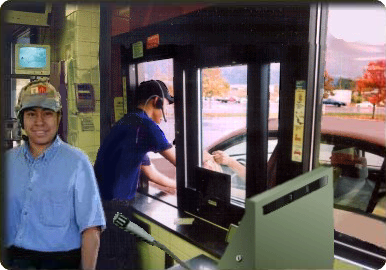
Drive-thru
The Drive-thru area of a restaurant offers young workers an opportunity for direct interaction with the customer, while learning food service and money handling skills. Young workers in this area may also be exposed to the following hazards:
Potential Hazard
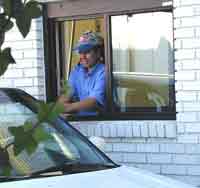
Employee exposure to automobile exhaust. Automobile exhaust contains harmful pollutants, primarily carbon monoxide. Carbon monoxide inhibits the ability of the blood to adsorb oxygen in the lungs. Inhaling high levels and concentrations can lead to poisoning. Carbon monoxide poisoning can result in headache, fatigue, flu-like symptoms, and potential heart problems, including chest pain, irregular heart beat, and cardiac arrest.
Possible Solutions
Employers have the primary responsibility for protecting the safety and health of their workers. Employees are responsible for following the safe work practices of their employers.
-
Keep the drive-thru window closed as much as possible to limit exposure to automobile exhaust.
Employers have the primary responsibility for protecting the safety and health of their workers. Employees are responsible for following the safe work practices of their employers.
Consider implementing recommended safe work practices, including:
-
Provide adequate space and ventilation for both exterior and interior drive-thru areas.
-
Use a reverse-flow fan system to prevent exhaust from entering the interior drive-thru window area.
-
Rotate workers to minimize time spent stationed in the drive-thru area.
Noise-induced hearing loss is 100-percent preventable. However, once acquired, hearing loss is permanent and irreversible.
Potential Hazard
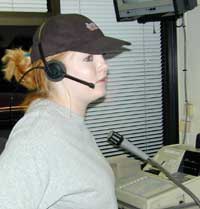
Restaurant workers may be exposed to noise, especially while working in the drive-thru area. Young workers often wear headsets to hear orders when working at drive-up windows. Young workers may potentially be exposed to loud headset background noise while wearing headsets.
Possible Solutions
Employers have the primary responsibility for protecting the safety and health of their workers. Employees are responsible for following the safe work practices of their employers.
-
Fit headsets properly to your head.
-
Don't turn headset volumes up excessively high.
-
See your doctor if you are experiencing ringing in your ears or problems with hearing.
Employers have the primary responsibility for protecting the safety and health of their workers. Employees are responsible for following the safe work practices of their employers.
Follow OSHA standards including:
- OSHA's general industry standard for noise, 1910.95 Occupational Noise Exposure if applicable:
- Implement feasible administrative and engineering controls whenever employee noise exposures exceed 85 dBA (eight-hour time-weighted average (TWA) or a dose of 50%).
-
When this occurs, OSHA requires employers to notify employees, to establish and maintain a hearing test program, and to train workers how to prevent occupational hearing loss.
-
- Implement feasible administrative and engineering controls whenever employee noise exposures exceed 85 dBA (eight-hour time-weighted average (TWA) or a dose of 50%).
Consider implementing recommended safe work practices, including:
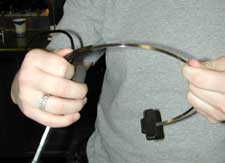
-
Use acoustical limiting devices in your headsets. Headsets that use acoustical limiting devices are designed to provide sufficient protection to keep the noise level below the level required by OSHA. Headsets without limiting devices have, in some work environments, caused employee noise exposures to exceed the levels permitted by OSHA.
-
Use good quality microphones in your drive-thru to improve reception capabilities.
-
Ensure the headset fits the worker properly. Adjustable headsets work best. Ask if alternative ear pieces can be provided to fit different ear sizes.
-
Reduce individual employee exposure time to loud noises by rotating workers through the drive-thru area.
-
Have a safety and health program that recognizes and addresses the hazards created by workplace noise exposure.
Additional Resources
-
Occupational Noise Exposure. OSHA Safety and Health Topics Page.
-
Noise. OSHA Technical Manual Chapter.
-
Hearing Conservation. OSHA Publication 3074, (2002)
-
Noise and Hearing Loss Prevention. National Institute for Occupational Safety and Health (NIOSH) Workplace Safety and Health Topic.
-
Guidelines for Noise Enforcement; Appendix A. OSHA Directive CPL 02-02-035 [CPL 2-2.35A], (December 19, 1983).
-
Noise Sound Level Meter App. National Institute for Occupational Safety and Health (NIOSH) . A tool to measure sound levels in the workplace and provide noise exposure parameters to help reduce occupational noise-induced hearing loss.
-
Noise Induced Hearing Loss. National Institutes of Health, National Institute on Deafness and Other Communication Disorders.
Potential Hazard
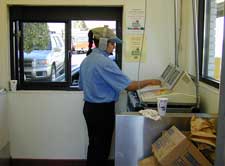
Employee exposure to prolonged standing while working the drive-thru window can cause stress and strain to workers' backs and legs.
Possible Solutions
Employers have the primary responsibility for protecting the safety and health of their workers. Employees are responsible for following the safe work practices of their employers.
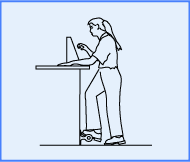
To relieve stress and strain to workers' backs and legs:
-
Wear shoes with well-cushioned insteps and soles.
-
Avoid static postures by continually altering your position. Use a foot rest bar or a low stool to help alter your posture by raising one foot and then the other.
Employers have the primary responsibility for protecting the safety and health of their workers. Employees are responsible for following the safe work practices of their employers.
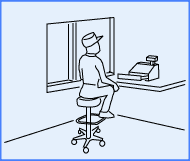
Consider implementing recommended safe work practices, including:
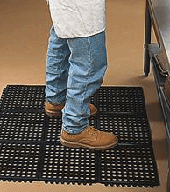
-
Provide stools or a foot rest bar at work stations. This provides employees an opportunity to shift weight from the feet while still maintaining reach and accessibility.
-
Provide anti-fatigue mats. Anti-fatigue mats help contract and expand muscles of the person standing on them increasing blood-flow and reducing fatigue.
Potential Hazard
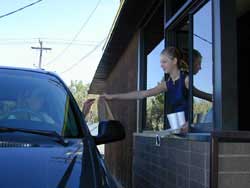
Employee exposure to strains and sprains from tasks that require repetitive motions. Tasks such as excessive reaching, lifting, and leaning out of drive-thru windows to hand customers their orders may lead to injuries.
Possible Solutions
Employers have the primary responsibility for protecting the safety and health of their workers. Employees are responsible for following the safe work practices of their employers.
-
Avoid twisting while lifting.
-
Avoid overreaching. Walk food out to customers if they are parked too far away for you to safely reach from the drive-thru window.
-
Stay fit to help avoid injuries.
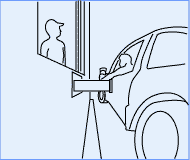
Employers have the primary responsibility for protecting the safety and health of their workers. Employees are responsible for following the safe work practices of their employers.
-
Rearrange workstations to provide for easy access to items used most frequently and to enable employees to keep their elbows close to the body.
-
Redesign drive-thru windows to alleviate employee reaching. Rather than having employee reach across a window to deliver food, install a drop box to put orders into to deliver orders to customers. Customers then reach into the drop box to get their order.
-
Rotate workers through the drive-thru area to limit their exposure to excessive reaching and lifting and the development of musculoskeletal disorders
Additional References
-
Ergonomics. OSHA Safety and Health Topics Page.
Workplace violence is violence or the threat of violence, against workers. It can range from threats and verbal abuse to physical assaults and homicides from behaviors initiated by customers, other employees, and employers.
Potential Hazard
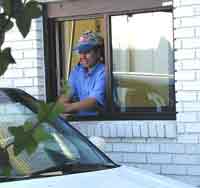
 Remember: Child labor laws restrict the hours and times young workers under the age of 18 can work.
Remember: Child labor laws restrict the hours and times young workers under the age of 18 can work.
Many workplaces, like restaurants, can be a target for workplace violence because of the presence of cash, the late work hours and contact with the public. Young workers may also be exposed to workplace violence in restaurant drive-thru windows. In addition, sometimes the drive-thru is located in a structure removed from the main restaurant, isolating the teen from the support of fellow workers.
Possible Solutions
Employers have the primary responsibility for protecting the safety and health of their workers. Employees are responsible for following the safe work practices of their employers.
-
Use drop-boxes if available to deliver food to customers, especially late at night.
-
Keep the back door locked unless receiving deliveries.
Employers have the primary responsibility for protecting the safety and health of their workers. Employees are responsible for following the safe work practices of their employers.
- Follow the child labor laws that restrict workers younger than 16 years old from working after 7 p.m. except from June 1st through Labor Day, when evening hours are extended to 9 p.m. Do not leave young workers alone at night to lockup.
Consider implementing recommended safe work practices, including:
-
Install bulletproof glass and limited access barriers for drive-thru windows.
-
Increase workplace security by installing video surveillance, alarm systems, and door detectors.
-
Increase lighting in dimly lit areas such as parking lots and around trash dumpsters.
-
Locate drive-thru windows within the same building as the restaurant, rather than in the parking lot by itself.
 For more information see, Serving - Workplace Violence.
For more information see, Serving - Workplace Violence.
Additional Resources
-
Workplace Violence. OSHA Safety and Health Topics Page.

